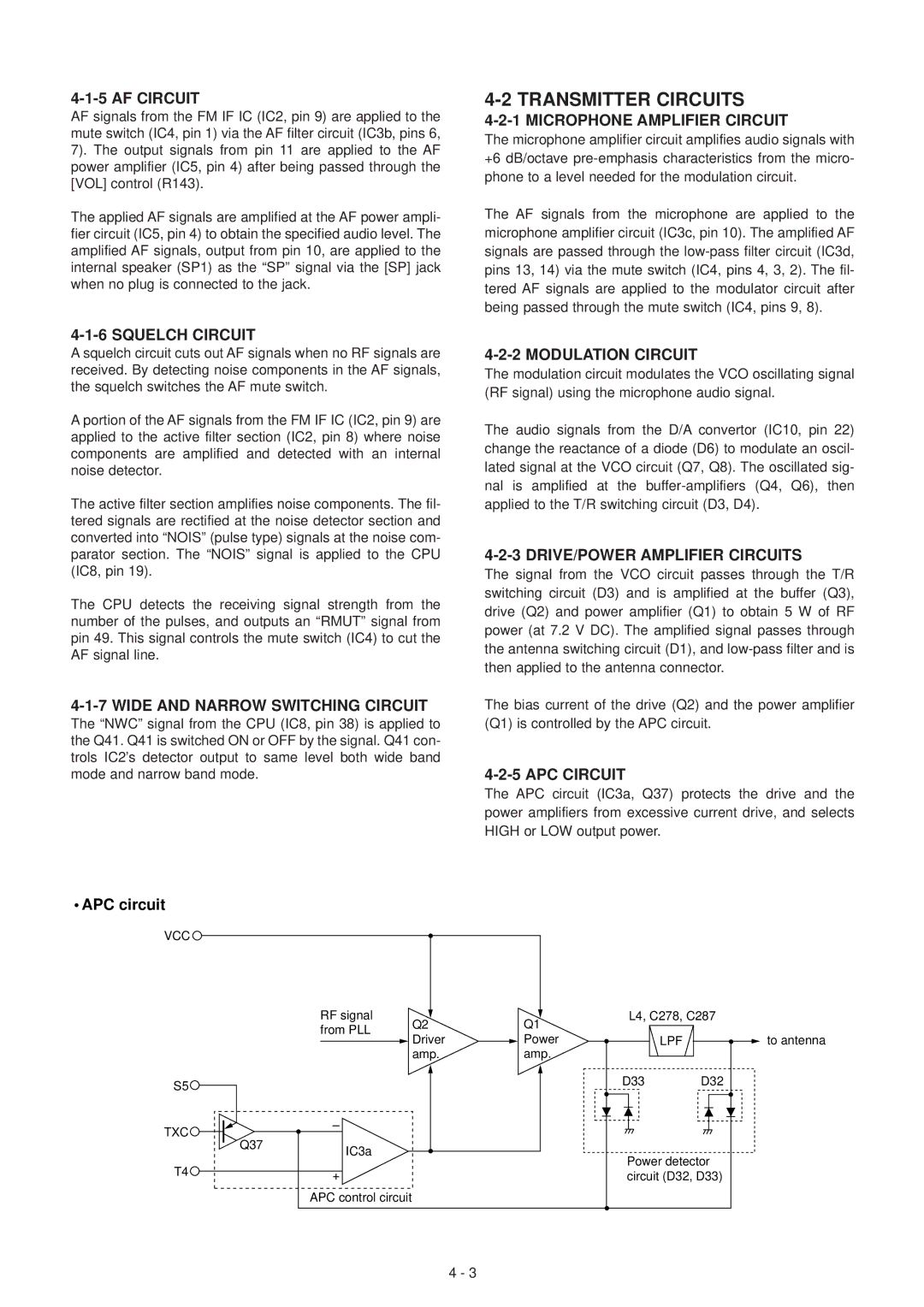
4-1-5 AF CIRCUIT
AF signals from the FM IF IC (IC2, pin 9) are applied to the mute switch (IC4, pin 1) via the AF filter circuit (IC3b, pins 6, 7). The output signals from pin 11 are applied to the AF power amplifier (IC5, pin 4) after being passed through the [VOL] control (R143).
The applied AF signals are amplified at the AF power ampli- fier circuit (IC5, pin 4) to obtain the specified audio level. The amplified AF signals, output from pin 10, are applied to the internal speaker (SP1) as the “SP” signal via the [SP] jack when no plug is connected to the jack.
4-2 TRANSMITTER CIRCUITS
4-2-1 MICROPHONE AMPLIFIER CIRCUIT
The microphone amplifier circuit amplifies audio signals with +6 dB/octave
The AF signals from the microphone are applied to the microphone amplifier circuit (IC3c, pin 10). The amplified AF signals are passed through the
4-1-6 SQUELCH CIRCUIT
A squelch circuit cuts out AF signals when no RF signals are received. By detecting noise components in the AF signals, the squelch switches the AF mute switch.
A portion of the AF signals from the FM IF IC (IC2, pin 9) are applied to the active filter section (IC2, pin 8) where noise components are amplified and detected with an internal noise detector.
The active filter section amplifies noise components. The fil- tered signals are rectified at the noise detector section and converted into “NOIS” (pulse type) signals at the noise com- parator section. The “NOIS” signal is applied to the CPU (IC8, pin 19).
The CPU detects the receiving signal strength from the number of the pulses, and outputs an “RMUT” signal from pin 49. This signal controls the mute switch (IC4) to cut the AF signal line.
4-1-7 WIDE AND NARROW SWITCHING CIRCUIT
The “NWC” signal from the CPU (IC8, pin 38) is applied to the Q41. Q41 is switched ON or OFF by the signal. Q41 con- trols IC2’s detector output to same level both wide band mode and narrow band mode.
• APC circuit
4-2-2 MODULATION CIRCUIT
The modulation circuit modulates the VCO oscillating signal (RF signal) using the microphone audio signal.
The audio signals from the D/A convertor (IC10, pin 22) change the reactance of a diode (D6) to modulate an oscil- lated signal at the VCO circuit (Q7, Q8). The oscillated sig- nal is amplified at the
4-2-3 DRIVE/POWER AMPLIFIER CIRCUITS
The signal from the VCO circuit passes through the T/R switching circuit (D3) and is amplified at the buffer (Q3), drive (Q2) and power amplifier (Q1) to obtain 5 W of RF power (at 7.2 V DC). The amplified signal passes through the antenna switching circuit (D1), and
The bias current of the drive (Q2) and the power amplifier (Q1) is controlled by the APC circuit.
4-2-5 APC CIRCUIT
The APC circuit (IC3a, Q37) protects the drive and the power amplifiers from excessive current drive, and selects HIGH or LOW output power.
VCC
RF signal | Q2 |
| Q1 | L4, C278, | C287 | |||
from PLL |
|
|
|
|
|
| ||
Driver |
| Power |
| LPF |
|
| to antenna | |
|
|
|
|
| ||||
|
|
|
| |||||
| amp. |
| amp. |
|
|
|
|
|
S5![]()
TXC |
| – |
Q37 |
| |
| IC3a | |
|
| |
T4 |
| + |
|
|
APC control circuit
D33 D32
Power detector circuit (D32, D33)
4 - 3
